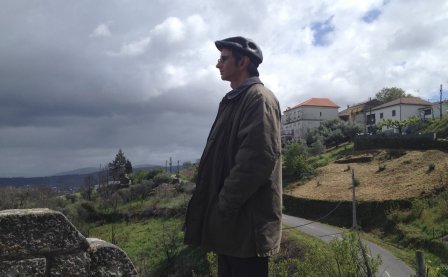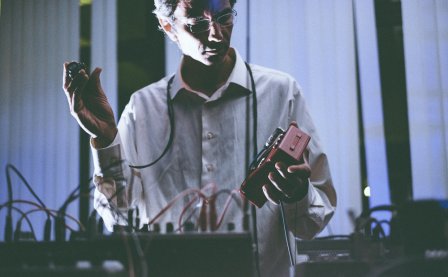Space, for left-field musician Rafael Toral, is neither a final destination nor a beginning — at least space as it’s normally understood. Whether suspended in the gossamer haze of his early ambient work, honed to precarious improvisations in his Space Program series (which recently concluded after a 13-year voyage), or, freed from paternal stricture in his present projects, gone renegade past the pearly gates of free-jazz, Toral’s work has little to do with stargazing and everything to do with positioning.
Advancing a jazz-infused language that Toral first developed during the Space Program, Space Quartet aerate compositions with brisk improvisations. Quite fittingly, the cover art for the group’s self-titled debut pays homage to the aesthetic cool of 1960s-era jazz label Blue Note — it echoes the shuttered cover of Freddie Hubbard’s Hub-Tones, specifically — while sharing an easel with De Stijl painters, recalling Piet Mondrian’s kinetic rectangles, formed using only black, white, and primary colors.
But Space Quartet don’t make hard bop nor do they play standards. Electronic instruments serve a role normally reserved for culprits like guitar, piano, or saxophone, with Toral’s melodic feedbacks and hacked amplifiers pouncing and twining with Ricardo Webbens’s modular synthesizer and custom electronics. The dueling voices conjure exotic bird calls transmitted through radio static, shrieking in beautiful discord. No less vivacious, the rhythm section — featuring Hugo Antunes on double bass, and João Pais Filipe on drums and handmade gongs and bells — teems with power and precision, rumbling with rib-rattling thunderclaps.
Evoking fertile landscapes, Space Quartet’s four tracks reference places in Portugal where the album was recorded: “Lisboa,” Europe’s second oldest capital, predating London, Paris, and Rome; “Porto,” a northern port resting near the mouth of the River Douro; “Coimbra,” a city in central Portugal housing the country’s oldest academic institution; and “Lisbon II,” Lisbon being the Western term for Lisboa, also the site of Toral’s birthplace. Forget about passports: one can nearly taste grapes plucked along the Douro, hear fields of wheat toss in the gentlest breeze, see Roman ruins sunning on bare hillsides.
Neither a tour guide nor a band leader, Toral considers himself, more poetically, “an ‘architect’ of spontaneous configurations.” The sonic structures he designed for Space Quartet involved isolated interactions with each musician. During a three-year editorial process, Toral guided the group’s musical materials using a meta-score, evaluating how well they served compositional functions concerning rhythm, density, timbre, articulation, and even mood. When the group gathered together in November 2017, the compositions were brought to life for the first time. Only the musical materials, which are laid out in a timed score, were pre-established; each musician decided, on their own, when and how to perform their chosen materials, maintaining the freedom and accountability to improvise.
“Lisboa I,” the album’s smoldering 18-minute opener, proudly confirms the group’s jazz allegiance. Each musician enters sequentially, allowing space for the others to pause. A ghostly melody warbles from Toral’s feedback systems, lost in soliloquy, before the bass yo-yos through center stage; drums splatter overhead, followed by loopy electronics. After lathering to a frenzy, the group pulls back, unraveling in moonlight. “Porto,” meanwhile, seeps from foggy riverbanks resembling Toral’s sporadic side-project MIMEO — an electroacoustic collective that channels sheets of noise sometimes soft enough to huff from a humidifier, other times dense as magnetic storms. While “Porto’s” electronics blink like fireflies, Pais Filipe massages gongs in sleepy washes. Finding new knees in old sea legs, the bass creeps down a noir-ish alley, rallying the group to one final flurry.
Ablaze from the start, “Coimbra” ticks, clicks, and clatters like a watchmaker’s shop gaining sentience one stroke past midnight. The bass seesaws in bristling brush strokes; the drums thrash in cyclical cells; Toral whorls feedback as Webbens gargles white noise. In the concluding passage, Antunes weaves a knotted melody that would raise Arnold Schönberg’s head. Finally, the walls are not crawling with field mice, but the squeaking chatter on “Lisbon II” could rouse a rodent’s nest. Beneath the whiskered fray, the bass signals in Morse code, tangling with buckshot drum blasts. Webbens tears through some feverish dimension conceived deep in a Hawking dream. Amid spasms, Toral’s feedback shakes like a landlocked siren, wailing higher, higher, higher.
Although old-school jazz fans might question the quartet’s instruments or squint at its lexicon, they just might savor the syntax, flick a match at its breathless exuberance. Music, for Toral, is no passing recreation. Dark matter be damned; Space Quartet explore a dimension within which all things exist: “Through being mindful of space,” Toral explains, music can become “a metaphor for a way of relationship to others and to the environment.” And we believe him. One need not cross the stratosphere to commune with the future. Reaching further than NASA’s probes, forging a field both singular and universal, Space Quartet celebrate a here rather than a there: a place we all share — together.
More about: Hugo Antunes, João Pais Filipe, Rafael Toral, Ricardo Webbens, Space Quartet




